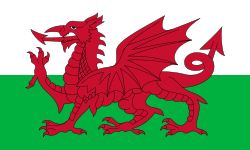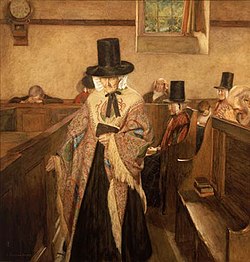Men were rarely illustrated or described wearing traditional attire in 19th century paintings. This was due to the fact that it was very similar to the attire worn by men in England. It consisted of a waistcoat (often of bright colours); a jacket often of blue or grey wool; a neckerchief; a pair of breeches; woollen stockings and a black felt hat, either like a bowler or one with a low, drum-shaped crown with a broad floppy brim. Although Welsh and English men's clothing were similar, the main difference between them in that Welsh clothing were often produced at locally. This meant that the majority of Welsh men wore blue or grey wool in the 18th century.
The majority of men in these images are wearing breeches and stocking, as trousers did not start becoming popular until the French Revolution in 1789, however Welsh Men continued to prefer the wearing of these breeches. In the Welsh published book 'History of Penmachno' it stated that in 1807 trousers began to replace the use of breeches. However men who are depicted wearing breeches even after the rise in popularity of the use of trousers is due to the fact that those documenting their clothing wanted to depict traditional clothing or their 'Sunday Best' instead of their work clothes.
Unfortunately, due to working clothing being consistently worn by these men in the period, almost none of these clothes have survived from the 18th and 19th century. There has also been few documentation or evidence of the use of fabrics and style. It is seen probable that as the majority of Welsh clothing at the time was made out of wool, and that the wool was produced locally, this could be said the same for men's working clothes. However further research is needed. From descriptions given by tourists about rural Welsh workers was that their clothing was often drab in colour, although kerchiefs and waistcoats were sometimes described as brightly coloured.
Descriptions of Men's Costume
(1738)
"The summit of his head is commonly crown'd with a Monmouth Cap and its crown is commonly pinnacles with the Battlement of a button" [13]
(1775)
"Saw several pair of flannel sheets drying. These were chiefly used by the common people who also frequently wear red flannel shirts" [14]
(1791)
"Men and women are almost indistinguishable except for breeches" [15]
(1798)
"The modern [man], like the ancient Briton, is not very attentive to food or clothing. The latter consists of a flannel jacket and breeches for men" [16]
(1803)
"A farming party also appeared at this instant, proceeding with goods for Carmarthen market. This group was opened by a robust young fellow driving a couple of cows; he wore the general dress of the country, a short blue coarse cloth coat; and breeches of the same, open at the knees; but he also possessed the luxury of shoes and stockings" [17]
(1804)
"I here had a specimen, if not a clerical poverty, at least of rusticity. A clergyman of the established church, dressed in a blue coat, striped waistcoat, a silk handkerchief round his neck, and a riding stick in his hand, stood in the throng, selling geese" [18]
(1805)
"the men generally wear grey or drab coloured cloth, manufactured out of the wool of their own country sheep, coarsely and tickly woven" [19]
(1807)
"The men wear a coarse woollen cloth of a sky blue colour for coat, breeches, and waistcoat, with worsted stockings of the same colour; through in Radnorshire the colour is a drab. Even many of the clergy are so prejudiced in favour of their paternal dress, that they despise a sable havit, and retain the country clothing" [20]
(1827)
"Today the Welsh lasses have thot proper to clothe their legs and feet. Yesterday in one walk from Merthyr we saw so much nakedness as quite to shock us. This, bye the bye is one of the means of distinction between the sexes for we never see the men without shoes or stockings" [21]
(1861)
"The men wear low-crowned hats, and are for the most part clothed in coats and vests of deep blue cloth, home spun and with brass buttons, have knee breeches of corduroy, and are very partial to showy silk neckcloths" [22]
(1878)
"A short man, broad, clumsy, wearing a coat of sky-blue cloth, corduroy breeches to the knee, a motley woollen waistcoat, a blue ribbon hanging on his breast, indicating the nature of his office and message through the country which he tramped; black woolen stocking on his legs, and two strong leathern boots on his feet; a hat made of rough cloth on his half-bare head" [23]
















